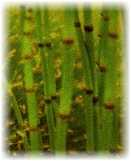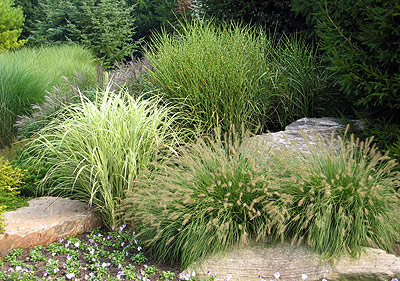| Every garden
needs the essentials, plants that are
a great investment because they survive
and thrive in their climate. Ornamental
grasses certainly fill the bill. You’d
have to try your hardest to kill these
fighters.
The practicality of ornamental grasses
is what makes them so popular. Use them
to fill in empty areas of the garden and
provide interest in the yard all year
round.
There are many varieties of ornamental
grasses, big ones such as pampas grass
with their gigantic feathery buff plumes
and smaller ones like Muhly grass with
its wispy, cloud-like pink plumes - all
of them putting on a fabulous show at
one time of the year or another.
Most ornamental grasses put on a show
in the fall and winter when the garden
is in need of a little extra boost. They’re
such adaptable plants that most of them
will prosper in any soil condition, and
neither drought nor floods will deter
them from acclimatizing and thriving.
Aside from providing year-round interest
in gardens ornamental grasses are virtually
impossible to kill. Most of them can survive
the most severe drought with no watering
at all.
The seed heads, plumes and foliage of
ornamental grasses are appealing for most
gardeners because of the vertical interest
they provide. The texture of ornamental
grasses are eye-catching and serve as
an excellent contrast for surrounding
shrubs. Maiden grass, with its frilly
plumes are one of our favorites.
 |
We use Maiden grass
more tha any other in landscape design.
This ia a tough ornamental grass with
stately appearance. The thin upright
foliage provides vertical interest
and a soft textured look in the landscape.
Its very drought tolerant so we combine
it with other drought
tolerant shrubs and perennials. |
In fact, we've never drawn a full-lot
design that didn't include ornamental
grasses. We use them all over the place:
the mid-size to larger ones around pools
and ponds, on either side of entryways,
as accents in shrub plantings or as screens
to hide an air conditioning unit or utility
box, or borders to define property lines.
We use mid-size and smaller species as
accents in flowerbeds, perennial gardens,
and centerpieces in containers. Some very
low growing grasses such as Liriope (Monkey
grass) are very useful as a grouncover
and others like Dwarf Mondo grass are
excellent for use between stepping stones
and pavers.
 |
If we find an area in
a landscape where there is moisture
retentive soil we almost always design
in some Horsetail grass (left). Horsetail
grass is one that actually prefers
life on the wet side. We usually combine
it with Iris pseudacorus and other
moisture-loving
plants. |
 |
There are several annual
grasses such as Purple (red) Fountain
grass and Purple Millet grass, though
not hardy, are worth mentioning for
their use in the garden. These grasses
are great to use as center pieces
for container gardening or as accents
in annual
flower beds. |
Though most go dormant, almost all ornamental
grasses add a significant vertical
presence to the winter landscape and are
commonly left standing until spring.
In the spring, grasses should be cut
back to make room for new growth. It’s
a good idea to wear gloves and a long-sleeved
shirt with some of the larger growing
varieties such as Pampas grass because
the blades can cause 'paper cuts'. A general
rule of thumb is to cut them back to about
6" or so above the ground before,
or just when you notice new growth begin
to emerge. Once this task is accomplished,
you should have a great arrangement of
dried grass plumes to bring indoors and
display in a large urn or vase!
In
Summary
- Grasses are adaptable and can grow
in poorer soils better than many other
garden plants.
- Grasses require little effort to
maintain.
- Grasses come in many heights, colors,
textures and have varying water requirements.
- Grass seed heads and foliage add
fall and winter interest.
Dried grasses have many decorative uses
indoors and out.
- Grasses can be used as groundcovers,
specimen plants, for erosion control,
and as vertical design elements.
- The term ornamental grass is used
to include not only true grasses (Gramineae)
but close relatives such as sedges (Cyperaceae),
rushes (Juncaceae), and others.
- Few pests bother grasses. About the
only maintenance required is the once
a year spring shearing.

Ornamental
Grasses
|